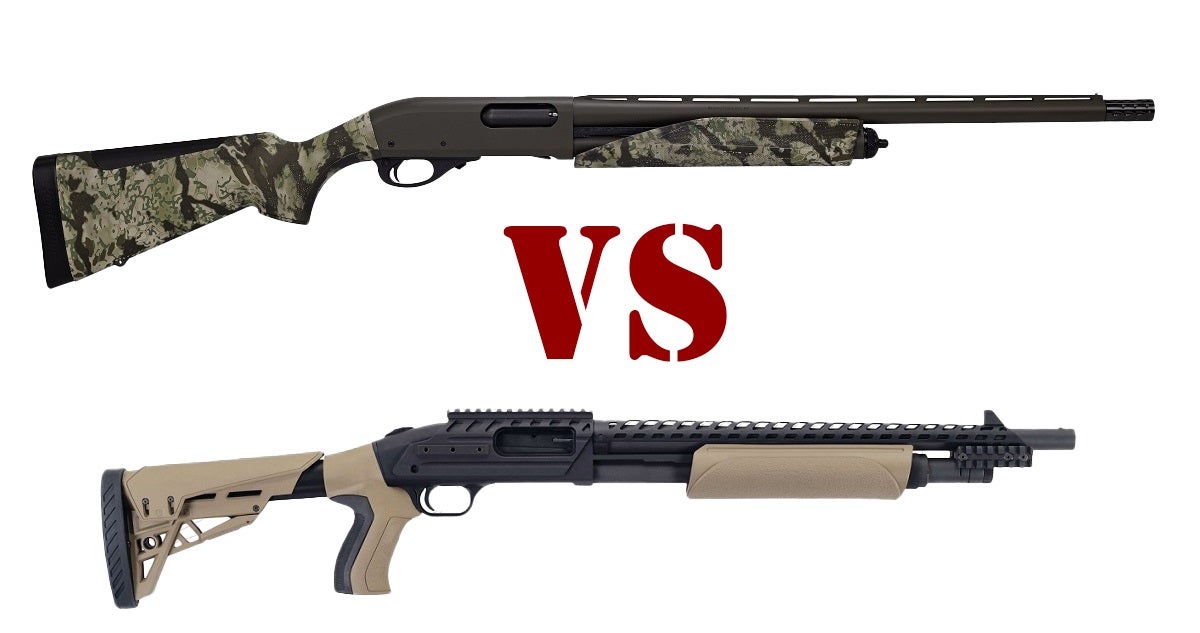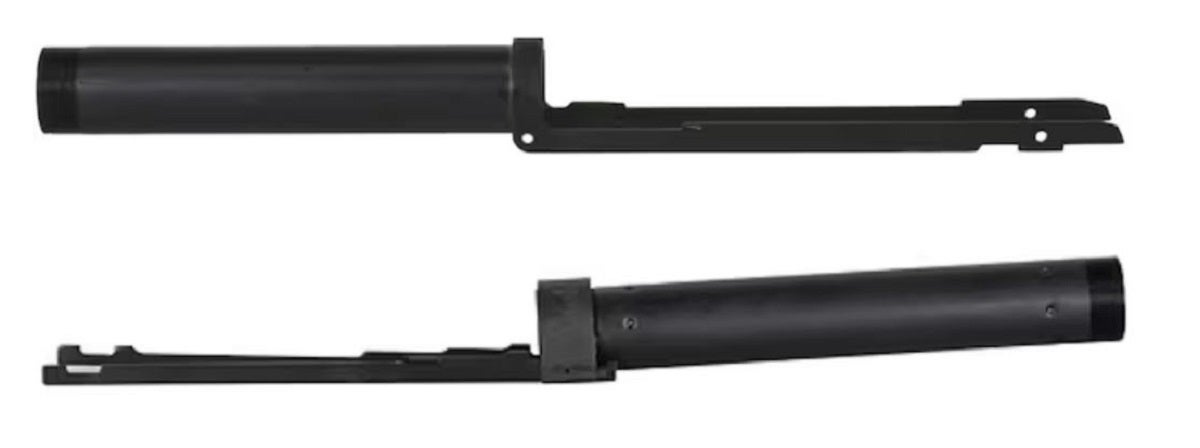Mossberg 500 vs. Remington 870: Is One Better Than The Other?
Travis Olander 01.12.24

It’s like comparing 9mm to .45 ACP, or strikers to hammers. Perhaps even comparing the GLOCK to the 1911 — but here, the contestants are more alike in form and function: The Mossberg 500 versus the Remington 870. These two legendary shotguns boast nearly identical lifespans and units manufactured. Both are practically as popular as the other, and both serve the same roles. Naturally, this has led many to endlessly argue that one shotgun is objectively better than the other. But if opinions and anecdotes are superseded by data, does one really reign supreme? Let’s start with basic specs.
Mossberg 500 & Remington 870 Coverage on AllOutdoor
- NEW Mossberg 500 & 835 Optic-Ready Turkey Shotguns w/ Holosun Sight
- Mossberg 500 Retrograde Field 12 GA – Vintage Curb Appeal, Modern Gun
- XS Sights Plus 2 Magazine Tube Extension for Remington 870 Shotguns
- Timney Triggers has a Fix for the Remington 870
Mossberg 500 Specifications

- Available Gauges: 12, 20, .410
- Available Barrel Lengths: 18.5″, 20″, 22″, 24″, 26″, 28″
- Receiver Material: Aluminum
- Trigger Pull: 8.5 lbs
- Weight: 7.0 lbs*
Weight based on 500 Field, 20 ga., 26″ barrel, 5+1 rounds
Remington 870 Specifications

- Available Gauges: 10, 12,16, 20, 28, .410
- Available Barrel Lengths: 18″, 20″, 21″, 23″, 25″, 26″, 28″, 30″
- Receiver Material: Steel
- Trigger Pull: 5.5 lbs
- Weight: 6.25 lbs*
Weight based on 870 Fieldmaster, 20 ga., 26″ barrel, 4+1 rounds
At a glance, these two shotguns are basically identical. They each provide myriad barrel lengths and the common gauges any shotgunner wants for security, hunting, or plinking. Both weigh damn near the same, with receivers, stocks, magazines, and slide assemblies that all look alike, too. But there are, indeed, some key differences between these two guns. Whether these differences are significant enough to justify wholly backing one over the other is another question that I’ll answer based on personal experience with both pump guns – but, spoilers: it’s nearly a toss-up. Let’s compare.
Mossberg 500 vs. Remington 870 Receivers: Does Metal Matter?
If you ask Remington guys this question, some will resoundingly declare that the Model 870’s solid steel receiver is “leaps and bounds more durable, rugged, and reliable” than the Mossberg 500’s receiver. Remington even leans into this, plastering the fact the 870 does sport a machined steel receiver atop its product page:
But having had the pleasure of fielding an M500 in the service, and having beat up a Mossberg 500 JIC and a Remington 870 over the past decade, I’m here to tell you this particular distinction doesn’t matter one bit. Yes, the Model 870’s steel receiver is objectively stronger. But the Mossberg’s receiver is also more than tough enough to withstand whatever you’re going to use either pump gun for. Drive a car over it, throw it against a wall, or do generally stupid, not-gun things to the Mossberg, and its receiver will hold up just as well as the 870’s steel workings.
The Mossberg also benefits from the fact that its receiver will won’t rust or pit. It’s superficial but, over time, the finish on either shotgun will take some nicks, scratches, and dents. Without a coating of some kind – and when left to sit in a dark safe or humid basement – bare steel will start to corrode. The weight difference between these two receivers also isn’t significant enough to make the heft nor felt recoil of one gun seem more advantageous than the other. On this comparison, consider it a practical tie.
One- vs. Two-Piece Slide Assemblies
But it’s here that things feel noticeable: The Mossberg 500’s slide assembly (bottom) uses a two-piece construction, separating the action bars from the slide that interfaces with the magazine and forend. The bars connect to the slide via two pins and a collar. The 870’s slide assembly (top) is a monolithic design, combining the action bars with the slide, foregoing any mechanical connections and fasteners. The result is that the 870’s pump action is objectively better. It’s crisper, tighter, smoother, and wobbles less than the Mossy’s pump. The 500 can also start to rattle after awhile, as the slide pins’ connections wear in.
Does this meaningfully impact cycling for the Mossberg? No. But is it something that a neurotic shooter – like myself – will find irritating enough to potentially consider one shotgun over the other? Yes. The Remington handily wins on this front.
Single vs. Double Extractors
The Mossberg 500 compensates for its inferior slide action with a superior bolt and extractor assembly. The Remington 870 relies on a single extractor, while the Mossy sports two claws for grabbing spent shells on either side of its bolt face. The Mossberg 500’s extractors are also milled from bar stock, while some 870s’ extractors are MIM-manufactured, or “metal injection molded”. This is just another name for casting metal, which results in a significantly softer alloy. Some users have reported issues with 870 MIM extractors rounding out and failing to grab brass, and plenty of aftermarket retailers have begun offering machined, “non-MIM” extractors made from hardened steel as an upgrade for these cycling issues.
Safeties & Slide Releases
The placement of both shotguns’ safeties and slide releases may or may not impact your ability to reliably handle either gun. If you’re a left-handed shooter, like this writer, you’ll greatly appreciate the Mossberg 500’s safety and slide lock. The 500’s safety rests atop the tang of the receiver, providing truly ambidextrous function and relatively easy access – though it is less ergonomic than the button-pressed safety on the 870, located just behind and to the left of the trigger, on its guard.
The 870’s slide toggle is easy to grab and ergonomic for any rightie, but lefties will find that it’s simply not convenient to reach without wrapping your hand around the receiver and squeezing it. This forces you to eliminate your shooting stance and change your high-ready grip entirely. The 500’s slide toggle rests where the 870’s safety sits, just beside the trigger guard. I always found it easy to depress it with my left index finger.
However, the detent on the Mossberg’s tang-top safety can wear in over time. In extreme cases (after thousands of rounds), the safety can loosen up to such an extent that recoil alone can reengage the safety. I’ve never seen this on any M500 nor my own shotgun, though. On this front, the better gun’s determined by your handedness: For lefties, the Mossberg’s controls are more ergonomic. For righties, the 870 provides a better fit.
Magazine Capacities
All 870s, save for one (the Special Purpose Marine Magnum), come fitted with a 4-round magazine tube, while 500s come optioned with a minimum 5-round tube. But a key difference that can impact capacity resides in both guns’ magazine caps: The Mossberg’s cap functions as a fastener that secures the barrel to the magazine and receiver. Once removed, the barrel is no longer connected. This eliminates aftermarket support for installing mag extensions on the Mossberg.
Meanwhile, the Remington’s magazine cap merely threads onto the magazine. It isn’t also responsible for securing the barrel to the action. When it’s removed, the magazine and barrel remain seated to the receiver. This allows the 870 to accept aftermarket mag extensions, like the Wilson Combat Extension pictured above. From the factory, the 500 wins on magazine capacity – but it loses to the 870 when it comes to adding more tube for extra shells.
Trigger Feel
The Remington 870’s trigger wins, hands down. Its metal trigger housing and overall construction is higher quality, and its lighter trigger weight and feel is all around superior. The 500’s trigger guard (which doubles as the trigger mechanism housing) is made from polymer, offering a sloppier feel. Coupled with its higher pull weight, its trigger just doesn’t feel as crisp nor consistent.
Feeding, Loading, and Ejecting
These statements may cause controversy. But too bad; I speak from years of experience with both guns: I prefer the Mossberg 500 in this category. The ‘Berg’s carrier (you might call it an elevator, or lifter) and spring have simply performed better for me, and others report the same when comparing both guns’ factory internals. This is also something that retailers have endeavored to fix on the 870, producing aftermarket spring upgrades and reshaped carriers for those who report feeding issues. I also like the Mossberg’s larger ejection port. It simply mitigates some jam risks, and it makes port loading in a hurry easier.
So, Is One Shotgun Superior?
No. Like I mentioned earlier, comparing the Remington 870 and Mossberg 500 is basically a wash. One gun is not universally better than the other. It’s the use case that’ll determine which shotgun is superior for your particular needs. I like the Remington’s quality. It simply feels better in the hands and its controls, trigger, and action are crisper and cleaner. But the Mossberg’s got a leg up – at least, from my own shooting adventures – when it comes to eating up and spitting out all kinds of shot shells without any fuss, and its left-handed ergonomics better suit my needs. In spite of its mushier trigger, wobbly action rods, and “cheaper” accoutrements, I prefer the 500 as my home-defense pump gun for its higher capacity and reliable cycling.
However, if I were inclined to do any kind of hunting with my shotguns, I would grab my 870 without hesitation. Its trigger and pump make for better consistency when dropping birds and big game. Now, that’s not to say the Mossberg isn’t a suitable duck or turkey gun – it definitely is, especially when paired with a Holosun optic. Check out these camouflaged, optics-ready 500s. Of course, the Remington 870 DM (paired with a detachable box mag) also makes for some great bird and boar hunting.




